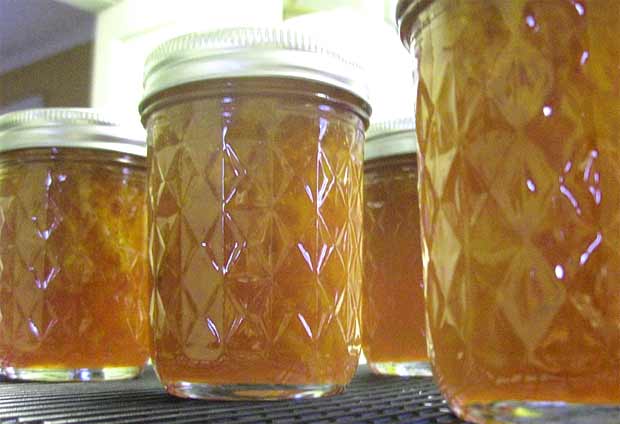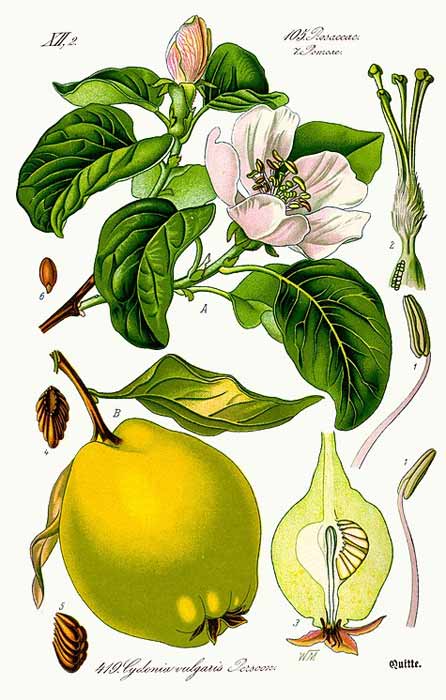Quince in herbal medicine
Quince (Cydonia oblonga) is a symbol of love and happiness. The fruit has been considered a love token throughout history and was often given as a gift.
Quince is also used in herbal medicine.

During the middle ages, quince was used at every wedding feast. Brides and grooms would nibble a quince to perfume their breath before entering the bridal chamber.
The quince, instead of the apple, may be the fruit from the Garden of Eden often associated with Eve.
Quince marmalade is added to pies, spread on toast, and served with meat dishes. Quince has more pectin than other fruits and gels easily.

Quince can stop diarrhea.
The quince fruit is sometimes made into syrup for the treatment of diarrhea. You can tell by the taste that it is very astringent. A bite of quince will make your mouth pucker!
Other ways that quince is used as a herbal medicine
Sometimes the seeds are used for their mucilage content, and are an excellent substitution for flax seeds.
When boiled with water the seeds form a thick ointment-like substance that is taken internally for treatment of dysentery, thrush, and irritable bowel conditions.
The Science of quince
Quince extract is shown to help in the treatment of irritable bowel diseases including ulcerative colitis and Crohn's disease.
It is an important dietary source in middle eastern countries and is traditionally used as a gastric tonic, anti-inflammatory, and ulcer healing agent.
It is also suitable for uterine and hemorrhoid bleeding. Both whole fruit juice and extract are effective.
Studies on quince also show it to be antiemetic, astringent, antimicrobial, and antioxidant. Visit my herbal glossary if you want to know more about medicinal properties.
Quince is also used to treat or prevent diabetes, cancer, high blood pressure, liver problems, thrombosis, and infections.
Leaves are used for cardiovascular disease, fruit is used for the colon, and seeds are used to treat cough, diarrhea, dysentery, constipation, sore throat, and bronchitis.
Quince contains phenolic compounds, essential oils, acids, glycosides, and terpenes.
The fruit also contains glucose, fructose, maltose, sucrose, vitamin C, sodium, calcium, phosphorus, potassium, and nitrogen.
Quince leaf, pulp, and peel extracts works a lot like green tea, but contain even stronger antioxidants.
An ancient fruit
Quince was once highly regarded as an herbal medicine, and the plant has been under cultivation since ancient times.
It was believed that quince provided protection from the evil eye and most gardens had least one quince tree.
The plant was considered necessary for making jams and jellies due to its high pectin content.
Quince was also made into a decoction and used as an eye wash or lotion. With such high mucilage content, "quince ointment" was not readily washed away by tears.
Quince was once very popular in the kitchen.
Senior citizens may fondly remember the scent of quince cooking in their mother’s kitchens. It is regrettable that the smell and taste of quince is now almost forgotten.
Quince makes delicious marmalade.
Many European countries consume large amounts of quince marmalade (the word marmalade originally meant “quince jam”). This sweet preserve is added to pies, spread on toast, and served with meat dishes.
In France, quince marmalade is mixed with rosewater and musk, resulting in a delicious preserve known for its digestive powers.
Visit the Royal Historical Society to see pictures and learn more about Quince.
Quince has a long history.
Quince is connected with Greek and Roman mythology and is often seen represented in ancient paintings and sculptures. Quince is depicted in the wall mosaics of Pompeii, where the fruit is often seen being held in the paws of a bear.
According to the Greeks and Romans, Quince was held sacred by Venus. Paris won Venus with a quince and she is often depicted with the fruit in her right hand.
In ancient literature, quinces are often referred to as golden apples. Some scholars believe that a quince was the “apple” or forbidden fruit referred to in the Garden of Eden.

Growing quince trees
Quince is a large shrub with pink blossoms and dark green leaves. Quince thrives in damp, rich soil.
The plant forms a thick bush that usually reaches only five or six feet in height.
Quince trees require a cold period to flower properly, and are self pollinating.
The ripe fruit is golden yellow and is shaped like a pear. Fruits are best left to ripen on the tree and picked after a frost.
Planting is done during the latter part of January or February when trees are completely dormant. Planting techniques and post-planting care are the same as for most other deciduous fruit trees.
*Please consult with your physician before using any herbal remedy.
Sources:
https://www.ncbi.nlm.nih.gov/pmc/articles/PMC3501898/
https://www.ncbi.nlm.nih.gov/pmc/articles/PMC9576383/
Blessings to you and yours!
Thanks so much for reading my blog. Jan.

*Note - the information on this website has not been evaluated by the Food and Drug Administration.
© 2005-2024 website design and content by Janice Boling